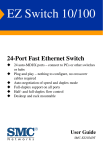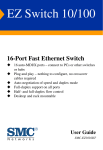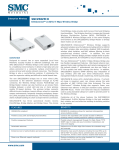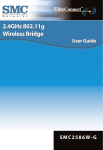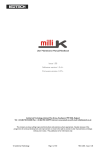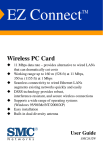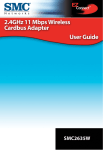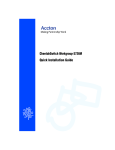Download SMC EZ Connect
Transcript
TM Wireless Access Point/Bridge ◆ Protocol-independent networking functionality ◆ 11 Mbps data rate per channel: provides alternative to wired LANs that can dramatically cut costs ◆ Seamless connectivity to wired Ethernet LANs augments existing networks quickly and easily ◆ Direct Sequence Spread-Spectrum (DSSS) technology provides robust and secure wireless connection ◆ Easy installation ◆ Omni-directional antenna User Guide SMC2682W EZ Connect User Guide From SMC’s EZ line of low-cost workgroup LAN solutions 38 Tesla Irvine, CA 92618 Phone: (949) 679-8000 January 2002 Part No: 01-111317-006 Pub No: 150000003400E R02 Copyright Information furnished by SMC Networks, Inc. (SMC) is believed to be accurate and reliable. However, no responsibility is assumed by SMC for its use, nor for any infringements of patents or other rights of third parties which may result from its use. No license is granted by implication or otherwise under any patent or patent rights of SMC. SMC reserves the right to change specifications at any time without notice. Copyright © 2002 by SMC Networks, Inc. 38 Tesla Irvine, CA 92618 All rights reserved. Printed in Taiwan Trademarks: SMC is a registered trademark; and EZ Connect is a trademark of SMC Networks, Inc. Other product and company names are trademarks or registered trademarks of their respective holders. LIMITED WARRANTY Limited Warranty Statement: SMC Networks, Inc. (“SMC”) warrants its products to be free from defects in workmanship and materials, under normal use and service, for the applicable warranty term. All SMC products carry a standard 90-day limited warranty from the date of purchase from SMC or its Authorized Reseller. SMC may, at its own discretion, repair or replace any product not operating as warranted with a similar or functionally equivalent product, during the applicable warranty term. SMC will endeavor to repair or replace any product returned under warranty within 30 days of receipt of the product. The standard limited warranty can be upgraded to a Limited Lifetime* warranty by registering new products within 30 days of purchase from SMC or its Authorized Reseller. Registration can be accomplished via the enclosed product registration card or online via the SMC web site. Failure to register will not affect the standard limited warranty. The Limited Lifetime warranty covers a product during the Life of that Product, which is defined as the period of time during which the product is an “Active” SMC product. A product is considered to be “Active” while it is listed on the current SMC price list. As new technologies emerge, older technologies become obsolete and SMC will, at its discretion, replace an older product in its product line with one that incorporates these newer technologies. At that point, the obsolete product is discontinued and is no longer an “Active” SMC product. A list of discontinued products with their respective dates of discontinuance can be found at: http://www.smc.com/index.cfm?action=customer_service_warranty All products that are replaced become the property of SMC. Replacement products may be either new or reconditioned. Any replaced or repaired product carries either a 30-day limited warranty or the remainder of the initial warranty, whichever is longer. SMC is not responsible for any custom software or firmware, configuration information, or memory data of Customer contained in, stored on, or integrated with any products returned to SMC pursuant to any warranty. Products returned to SMC should have any customer-installed accessory or add-on components, such as expansion modules, removed prior to returning the product for replacement. SMC is not responsible for these items if they are returned with the product. Customers must contact SMC for a Return Material Authorization number prior to returning any product to SMC. Proof of purchase may be required. Any product returned to SMC without a valid Return Material Authorization (RMA) number clearly marked on the outside of the package will be returned to customer at customer's expense. For warranty claims within North America, please call our toll-free customer support number at (800) 762-4968. Customers are responsible for all shipping charges from their facility to SMC. SMC is responsible for return shipping charges from SMC to customer. i LIMITED WARRANTY WARRANTIES EXCLUSIVE: IF AN SMC PRODUCT DOES NOT OPERATE AS WARRANTED ABOVE, CUSTOMER’S SOLE REMEDY SHALL BE REPAIR OR REPLACEMENT OF THE PRODUCT IN QUESTION, AT SMC’S OPTION. THE FOREGOING WARRANTIES AND REMEDIES ARE EXCLUSIVE AND ARE IN LIEU OF ALL OTHER WARRANTIES OR CONDITIONS, EXPRESS OR IMPLIED, EITHER IN FACT OR BY OPERATION OF LAW, STATUTORY OR OTHERWISE, INCLUDING WARRANTIES OR CONDITIONS OF MERCHANTABILITY AND FITNESS FOR A PARTICULAR PURPOSE. SMC NEITHER ASSUMES NOR AUTHORIZES ANY OTHER PERSON TO ASSUME FOR IT ANY OTHER LIABILITY IN CONNECTION WITH THE SALE, INSTALLATION, MAINTENANCE OR USE OF ITS PRODUCTS. SMC SHALL NOT BE LIABLE UNDER THIS WARRANTY IF ITS TESTING AND EXAMINATION DISCLOSE THE ALLEGED DEFECT IN THE PRODUCT DOES NOT EXIST OR WAS CAUSED BY CUSTOMER'S OR ANY THIRD PERSON'S MISUSE, NEGLECT, IMPROPER INSTALLATION OR TESTING, UNAUTHORIZED ATTEMPTS TO REPAIR, OR ANY OTHER CAUSE BEYOND THE RANGE OF THE INTENDED USE, OR BY ACCIDENT, FIRE, LIGHTNING, OR OTHER HAZARD. LIMITATION OF LIABILITY: IN NO EVENT, WHETHER BASED IN CONTRACT OR TORT (INCLUDING NEGLIGENCE), SHALL SMC BE LIABLE FOR INCIDENTAL, CONSEQUENTIAL, INDIRECT, SPECIAL, OR PUNITIVE DAMAGES OF ANY KIND, OR FOR LOSS OF REVENUE, LOSS OF BUSINESS, OR OTHER FINANCIAL LOSS ARISING OUT OF OR IN CONNECTION WITH THE SALE, INSTALLATION, MAINTENANCE, USE, PERFORMANCE, FAILURE, OR INTERRUPTION OF ITS PRODUCTS, EVEN IF SMC OR ITS AUTHORIZED RESELLER HAS BEEN ADVISED OF THE POSSIBILITY OF SUCH DAMAGES. SOME STATES DO NOT ALLOW THE EXCLUSION OF IMPLIED WARRANTIES OR THE LIMITATION OF INCIDENTAL OR CONSEQUENTIAL DAMAGES FOR CONSUMER PRODUCTS, SO THE ABOVE LIMITATIONS AND EXCLUSIONS MAY NOT APPLY TO YOU. THIS WARRANTY GIVES YOU SPECIFIC LEGAL RIGHTS, WHICH MAY VARY FROM STATE TO STATE. NOTHING IN THIS WARRANTY SHALL BE TAKEN TO AFFECT YOUR STATUTORY RIGHTS. * SMC will provide warranty service for one year following discontinuance from the active SMC price list. Under the limited lifetime warranty, internal and external power supplies, fans, and cables are covered by a standard one-year warranty from date of purchase. SMC Networks, Inc. 38 Tesla Irvine, CA 92618 ii COMPLIANCES FCC - Class B This equipment has been tested and found to comply with the limits for a Class B digital device, pursuant to Part 15 of the FCC Rules. These limits are designed to provide reasonable protection against harmful interference in a residential installation. This equipment generates, uses and can radiate radio frequency energy and, if not installed and used in accordance with instructions, may cause harmful interference to radio communications. However, there is no guarantee that the interference will not occur in a particular installation. If this equipment does cause harmful interference to radio or television reception, which can be determined by turning the equipment off and on, the user is encouraged to try to correct the interference by one or more of the following measures: • Reorient the receiving antenna • Increase the separation between the equipment and receiver • Connect the equipment into an outlet on a circuit different from that to which the receiver is connected • Consult the dealer or an experienced radio/TV technician for help Industry Canada - Class B This digital apparatus does not exceed the Class B limits for radio noise emissions from digital apparatus as set out in the interference-causing equipment standard entitled “Digital Apparatus,” ICES-003 of the Department of Communications. Cet appareil numérique respecte les limites de bruits radioélectriques applicables aux appareils numériques de Classe B prescrites dans la norme sur le matériel brouilleur: “Appareils Numériques,” NMB-003 édictée par le ministère des Communications. iii COMPLIANCES EC Conformance Declaration - Class B SMC contact for these products in Europe is: SMC Networks Europe, Edificio Conata II, Calle Fructuós Gelabert 6-8, 2o, 4a, 08970 - Sant Joan Despí, Barcelona, Spain. This information technology equipment complies with the requirements of the Council Directive 89/336/EEC on the Approximation of the laws of the Member States relating to Electromagnetic Compatibility and 73/23/EEC for electrical equipment used within certain voltage limits and the Amendment Directive 93/68/EEC. For the evaluation of the compliance with these Directives, the following standards were applied: RFI Emission: Immunity: LVD: iv * Limit class B according to EN 55022:1998 * Limit class A for harmonic current emission according to EN 61000-3-2/1995 * Limitation of voltage fluctuation and flicker in low-voltage supply system according to EN 61000-3-3/1995 * Product family standard according to EN 55024:1998 * Electrostatic Discharge according to EN 61000-4-2:1995 (Contact Discharge: ±4 kV, Air Discharge: ±8 kV) * Radio-frequency electromagnetic field according to EN 61000-4-3: 1996 (80 1000MHz with 1kHz AM 80% Modulation: 3V/m) * Electrical fast transient/burst according to EN 61000-4-4:1995(AC/DC power supply: ±1kV, Data/Signal lines: ±0.5kV) * Surge immunity test according to EN 61000-4-5:1995 (AC/DC Line to Line: ±1kV, AC/DC Line to Earth: ±2kV ) * Immunity to conducted disturbances, Induced by radio-frequency fields: EN 61000-4-6:1996 (0.15 - 80MHz with 1kHz AM 80% Modulation: 3V/m) * Power frequency magnetic field immunity test according to EN 61000-4-8:1993 (1A/m at frequency 50Hz) * Voltage dips, short interruptions and voltage variations immunity test according to EN 61000-4-11:1994 (>95% Reduction @10ms, 30% Reduction @500ms, >95% Reduction @5000ms) * EN 60950 (A1/1992; A2/1993; A3/1993; A4/1995; A11/1997) COMPLIANCES Safety Compliance Underwriters Laboratories Compliance Statement Important! Before making connections, make sure you have the correct cord set. Check it (read the label on the cable) against the following: Operating Voltage 120 Volts Cord Set Specifications UL Listed/CSA Certified Cord Set Minimum 18 AWG Type SVT or SJT three conductor cord Maximum length of 15 feet Parallel blade, grounding type attachment plug rated 15A, 125V 240 Volts (Europe only) Cord Set with H05VV-F cord having three conductors with minimum diameter of 0.75 mm2 IEC-320 receptacle Male plug rated 10A, 250V The unit automatically matches the connected input voltage. Therefore, no additional adjustments are necessary when connecting it to any input voltage within the range marked on the power adapter. v COMPLIANCES Wichtige Sicherheitshinweise (Germany) 1. Bitte lesen Sie diese Hinweise sorgfältig durch. 2. Heben Sie diese Anleitung für den späteren Gebrauch auf. 3. Vor jedem Reinigen ist das Gerät vom Stromnetz zu trennen. Verwenden Sie keine Flüssigoder Aerosolreiniger. Am besten eignet sich ein angefeuchtetes Tuch zur Reinigung. 4. Die Netzanschlu ßsteckdose soll nahe dem Gerät angebracht und leicht zugänglich sein. 5. Das Gerät ist vor Feuchtigkeit zu schützen. 6. Bei der Aufstellung des Gerätes ist auf sicheren Stand zu achten. Ein Kippen oder Fallen könnte Beschädigungen hervorrufen. 7. Die Belüftungsöffnungen dienen der Luftzirkulation, die das Gerät vor Überhitzung schützt. Sorgen Sie dafür, daß diese Öffnungen nicht abgedeckt werden. 8. Beachten Sie beim Anschluß an das Stromnetz die Anschlußwerte. 9. Verlegen Sie die Netzanschlußleitung so, daß niemand darüber fallen kann. Es sollte auch nichts auf der Leitung abgestellt werden. 10. Alle Hinweise und Warnungen, die sich am Gerät befinden, sind zu beachten. 11. Wird das Gerät über einen längeren Zeitraum nicht benutzt, sollten Sie es vom Stromnetz trennen. Somit wird im Falle einer Überspannung eine Beschädigung vermieden. 12. Durch die Lüftungsöffnungen dürfen niemals Gegenstände oder Flüssigkeiten in das Gerät gelangen. Dies könnte einen Brand bzw. elektrischen Schlag auslösen. 13. Öffnen sie niemals das Gerät. Das Gerät darf aus Gründen der elektrischen Sicherheit nur von authorisiertem Servicepersonal geöffnet werden. 14. Wenn folgende Situationen auftreten ist das Gerät vom Stromnetz zu trennen und von einer qualifizierten Servicestelle zu überprüfen: a. b. c. d. Netzkabel oder Netzstecker sind beschädigt. Flüssigkeit ist in das Gerät eingedrungen. Das Gerät war Feuchtigkeit ausgesetzt. Wenn das Gerät nicht der Bedienungsanleitung entsprechend funktioniert oder Sie mit Hilfe dieser Anleitung keine Verbesserung erzielen. e. Das Gerät ist gefallen und/oder das Gehäuse ist beschädigt. f. Wenn das Gerät deutliche Anzeichen eines Defektes aufweist. 15. Stellen Sie sicher, daß die Stromversorgung dieses Gerätes nach der EN 60950 geprüft ist. Ausgangswerte der Stromversorgung sollten die Werte von AC 7,5-8V, 50-60Hz nicht über oder unterschreiten sowie den minimalen Strom von 1A nicht unterschreiten. Der arbeitsplatzbezogene Schalldruckpegel nach DIN 45 635 Teil 1000 beträgt 70dB(A) oder weniger. vi TABLE OF CONTENTS EZ Connect™ Wireless AP/Bridge . . . . . . . . . . . . . . . . . . . . . . . . . . . . . 1 Introduction . . . . . . . . . . . . . . . . . . . . . . . . . . . . . . . . . . . . . . . . . . . . . . . . . 1 Package Checklist . . . . . . . . . . . . . . . . . . . . . . . . . . . . . . . . . . . . . . . . . . . . . 2 Hardware Description . . . . . . . . . . . . . . . . . . . . . . . . . . . . . . . . . . . . . . . . . 3 Ethernet Compatibility . . . . . . . . . . . . . . . . . . . . . . . . . . . . . . . . . . . 3 Radio Characteristics . . . . . . . . . . . . . . . . . . . . . . . . . . . . . . . . . . . . 3 Applications . . . . . . . . . . . . . . . . . . . . . . . . . . . . . . . . . . . . . . . . . . . . . . . . . 4 LED Indicators . . . . . . . . . . . . . . . . . . . . . . . . . . . . . . . . . . . . . . . . . . . . . . 5 System Requirements . . . . . . . . . . . . . . . . . . . . . . . . . . . . . . . . . . . . . . . . . . 6 Hardware Installation . . . . . . . . . . . . . . . . . . . . . . . . . . . 7 System Configuration . . . . . . . . . . . . . . . . . . . . . . . . . . . 8 Windows Installation (95/98/2000/Me/NT/XP) . . . . . . . . . . . . . . . . . . . 8 Bridge Information MIB . . . . . . . . . . . . . . . . . . . . . . . . . . . . . . . . . . . . . . 11 Bridge Control MIB . . . . . . . . . . . . . . . . . . . . . . . . . . . . . . . . . . . . . . . . . . 14 Encryption . . . . . . . . . . . . . . . . . . . . . . . . . . . . . . . . . . . . . . . . . . . 16 MAC Filter . . . . . . . . . . . . . . . . . . . . . . . . . . . . . . . . . . . . . . . . . . . 18 SNMP Settings . . . . . . . . . . . . . . . . . . . . . . . . . . . . . . . . . . . . . . . . 19 Reset Bridge . . . . . . . . . . . . . . . . . . . . . . . . . . . . . . . . . . . . . . . . . . 20 Factory Default . . . . . . . . . . . . . . . . . . . . . . . . . . . . . . . . . . . . . . . . 20 TCP/IP Settings . . . . . . . . . . . . . . . . . . . . . . . . . . . . . . . . . . . . . . . . . . . . . 20 Change Password . . . . . . . . . . . . . . . . . . . . . . . . . . . . . . . . . . . . . . . . . . . . 22 Network Configuration and Planning . . . . . . . . . . . . . 23 Network Topologies . . . . . . . . . . . . . . . . . . . . . . . . . . . . . . . . . . . . . . . . . 24 Ad hoc Wireless LAN (no AP or Bridge) . . . . . . . . . . . . . . . . . . . 24 Infrastructure Wireless LAN . . . . . . . . . . . . . . . . . . . . . . . . . . . . . 25 Infrastructure Wireless LAN for Roaming Wireless PCs . . . . . . . 26 Infrastructure for Bridging between LANs . . . . . . . . . . . . . . . . . . 27 Troubleshooting . . . . . . . . . . . . . . . . . . . . . . . . . . . . . . 29 SMC Networks 802.11b Wireless Product Maximum Distance Table . . . . 31 Specifications . . . . . . . . . . . . . . . . . . . . . . . . . . . . . . . . . 32 Terminology . . . . . . . . . . . . . . . . . . . . . . . . . . . . . . . . . 35 vii TABLE OF CONTENTS viii EZ CONNECT™ WIRELESS AP/BRIDGE Introduction SMC’s EZ Connect Wireless Access Point/Bridge (SMC2682W) is an 11 Mbps wireless bridge that allows two or more remote Ethernet LANs to be merged into a single virtual LAN. Workstations on each of the remote LANs may communicate with each other as though they were on the same physical LAN. The Wireless Access Point/Bridge can also function as an access point and provide transparent, wireless data communications between the wired LAN (and/or within the wireless network) and fixed, portable, or mobile devices equipped with a wireless adapter employing the same radio modulation. This solution offers fast, reliable wireless connectivity with considerable cost savings over wired LANs (which include long-term maintenance overhead for cabling). 1 EZ CONNECT™ WIRELESS AP/BRIDGE Package Checklist The EZ Connect Wireless Access Point/Bridge package includes: • 1 EZ Connect Wireless Access Point/Bridge (SMC2682W) • 1 Antenna (dipole, omni-directional) • 1 Power Adapter • 1 Utility Diskette • This User Guide Please register this product and upgrade the product warranty at www.smc.com. Inform your dealer if there are any incorrect, missing, or damaged parts. If possible, retain the carton and the original packing materials. Use them again to repack the product if there is a need to return it. 2 HARDWARE DESCRIPTION Hardware Description Ethernet Compatibility SMC’s EZ Connect Wireless Access Point/Bridge attaches directly to 10BASE-T (Twisted Pair) Ethernet LAN segments. These segments must conform to the IEEE 802.3 specification. The AP/Bridge appears as an Ethernet node and performs a routing function by moving packets from the wired LAN to remote workstations on the wireless infrastructure. Radio Characteristics The Wireless AP/Bridge uses a radio modulation technique known as Direct Sequence Spread Spectrum transmission (DSSS), and a shared collision domain (CSMA/CA). It operates in the 2.4 GHz license-free Industrial Scientific and Medical (ISM) band. Data is transmitted over a half-duplex radio channel operating at up to 11 Mbps per second. 3 EZ CONNECT™ WIRELESS AP/BRIDGE Applications EZ Connect wireless products offer a fast, reliable, and cost-effective solution for wireless Ethernet client access to the network in applications such as: 4 • Remote access to corporate network information E-mail, file transfer, and terminal emulation • Difficult-to-wire environments Historical or old buildings, asbestos installations, and open areas where wiring is difficult to employ • Frequently changing environments Retailers, manufacturers, and banks that frequently rearrange the workplace or change location • Temporary LANs for special projects or peak times Trade shows, exhibitions, and construction sites that need to setup for a short time period. Retailers, airline, and shipping companies that need additional workstations for a peak period. Auditors who require workgroups at customer sites • Access to databases for mobile workers Doctors, nurses, retailers, or white-collar workers who need access to databases while being mobile in a hospital, retail store, in an office, or on a campus • SOHO users SOHO (Small Office and Home Office) users who need quick and easy installation of a small computer network • Building-to-building connectivity Connect detached sites into a single LAN, even when they are separated by obstacles such as freeways, railroads, or bodies of water that are practically insurmountable for copper and fiber-optic cable LED INDICATORS LED Indicators The EZ Connect Wireless Access Point/Bridge includes five status LED indicators, as described in the following figure and table. Wireless Activity Power Ethernet Link LED Ethernet Activity Status Wireless Link Description Power On (Red) Indicates power is being supplied. Ethernet Link On (Green) Indicates a valid Ethernet cable link. Ethernet Activity Flashing (Orange) Indicates that the AP/Bridge is transmitting or receiving data on the Ethernet LAN. Wireless Link Wireless Activity Flashing (Green) Indicates valid Bridge Master* connection to wireless stations. The rate of flashing increases with the number of links. On (Green) Indicates valid Bridge Slave* connection to Bridge Master. Flashing (Orange) Indicates that the AP/Bridge is transmitting or receiving data through wireless links. * Refer to “Infrastructure for Bridging between LANs” on page 27. 5 System Requirements Before you install the EZ Connect Wireless Access Point/Bridge, be sure you can meet the following requirements: 6 • An A/C power outlet (100~240 V, 50~60 Hz) • An available RJ-45 (UTP) port on a 10BASE-T Ethernet hub or switch • Wireless clients with IEEE 802.11b-compliant Ethernet adapters installed • A management station (PC) on the LAN running Windows 95/98/ 2000/NT/Me/XP with the TCP/IP protocols installed • Web browser for configuration HARDWARE INSTALLATION 1. Select the Site – Choose a location for your SMC2682W Wireless Access Point/Bridge. Usually the best place is at the center of your wireless coverage area, within line-of-sight of all wireless devices. Try to place the AP/Bridge in a position that can best cover its BSS (refer to page 25). Normally, the higher you place the antenna, the better the performance (see page 31 for the maximum distances allowed between clients and the AP/Bridge.) 2. Attach the Antenna – Screw the antenna into the antenna connector on the back panel. RJ-45 Connector Antenna Connector RS-232 Port Reset Button DC 9V Power Cable 3. Connect the Ethernet Cable – The 10BASE-T Ethernet port on the AP/Bridge can be connected to a network device such as a hub or a switch. Connect Category 3, 4, or 5 UTP Ethernet cable to the RJ-45 socket on the back panel. 4. Connect the Power Cable – Connect the power adapter cable to the 9 VDC power socket on the rear panel. Warning: Use ONLY the power adapter supplied with the SMC2682W. 7 SYSTEM CONFIGURATION The diskette labeled “Utility Diskette” that comes with the package contains a utility program for the EZ Connect Wireless Access Point/ Bridge. Updates may be downloaded from SMC’s web site at: http://www.smc.com Warning: Back up your utility diskette and use the copy as the working diskette to protect the original from accidental damage. The SMC2682W can be configured over an Ethernet network connection via its RJ-45 port. Connect the SMC2682W to any Ethernet device such as a hub or switch. Run the utility program and configure the unit remotely as described below: Windows Installation (95/98/2000/Me/NT/XP) 1. Insert the SMC2682W utility disk into the floppy drive on your PC, and then enter the following command: “A:\utility\setup.” Follow the on-screen instructions to install the utility program. 2. Run the installed utility, click on “AP/Bridge” and then select “Scan” from the menu. The program will detect all SMC2682W Wireless AP/ Bridges on the network. 3. If DHCP is turned “ON” (default setting, page 20) and a DHCP 8 WINDOWS INSTALLATION (95/98/2000/ME/NT/XP) server is located on the network, the AP/Bridge will automatically be assigned an IP address when booted. Otherwise, you can manually configure a temporary address. From the list of detected devices, select and double-click on the unit you want to configure. The “Assign Temporary IP Address” dialog box will appear. The utility will display IP information based on what it gathered from the network settings on your computer. You may change these settings if required, or click OK if you would like to use the IP information the utility generated. 4. A second box will pop up, informing you that the IP address you have assigned is only temporary. Click OK and the utility will appear again, listing the device again, this time with IP information. 9 SYSTEM CONFIGURATION 5. From the list, again select and double-click on the unit you want to configure. This time a Web browser page will appear. 6. Enter the password “WLAN_BRIDGE” and click “Login.” This will take you to the home page. 7. Click on “Bridge Information MIB,” “Bridge Control MIB,” “TCP/IP Settings,” or “Change Password” to select the page required. 10 BRIDGE INFORMATION MIB Bridge Information MIB This page displays the information shown below. Bridge Name – The name that appears in the Bridge Utility window when an AP/Bridge is detected (page 8). It can be configured under “Bridge Control MIB” on page 14. Bridge Firmware Version – The current firmware version for the AP/ Bridge. BSS ID – The MAC address of the AP/Bridge. Association Number – The number of PCs linked to the AP/Bridge at this time. 11 SYSTEM CONFIGURATION IP Address, Subnet Mask, Default Gateway, DHCP – If DHCP is displayed as “Client” (i.e., the default) in a network with a DHCP server, the DHCP server will assign the TCP/IP settings. If there is no DHCP server on the network, you can assign a temporary IP address using the Wireless Bridge Utility (page 8). Once you have access to the Web interface, you can configure permanent TCP/IP values using “TCP/IP Settings” (page 20). DS Channel – The radio channel through which the AP/Bridge communicates with PCs in its BSS (the default is 11). Note that the DC channel for wireless clients is automatically set to the same as that used by the AP/Bridge to which it is linked. SSID – The Service Set ID. This must be the same for all stations in the BSS and is configured under “Bridge Control MIB” on page 14 (the default is BRIDGE.) Bridge Up Time – The time that the AP/Bridge has been operating in its current configuration since being switched on. 12 BRIDGE INFORMATION MIB Advanced Status – Click this button to display additional information about the AP/Bridge configuration as shown below: 11 Mbps Signal Strength – Shows the relative strength of the wireless connection to the Bridge Master. Link Quality – Shows the relative link quality (e.g., lack of frame errors) of the wireless connection to the Bridge Master. 13 SYSTEM CONFIGURATION Bridge Control MIB Use this page to configure the wireless parameters described below; then click on “Apply Changes” to implement the settings. Bridge Name – Sets the name that appears in the Wireless Bridge Utility window when an AP/Bridge is detected (page 8.) Network Type – Sets the operating mode of the Bridge. This field can be set to “Access Point,” “Bridge Master” or “Bridge Slave” (Default: Bridge Master.) DS Channel – Set the channel number used for the operating radio channel. 14 BRIDGE CONTROL MIB The available channel settings are displayed to the right of the “DS Channel” field. Local regulations determine which channels are available: FCC/IC: 1-11, ETSI: 1-13, France: 10-13, Spain: 10-11, MKK: 1-14. SSID – This must be set to the same value as other wireless devices in your network (Default: BRIDGE). Note: The SSID is case sensitive and can consist of up to 32 alphanumeric characters. RTS Threshold – Set the RTS Threshold to the same as that used by other devices in your network (Default: 2305, which means Disabled). 15 SYSTEM CONFIGURATION Encryption Click the Encryption icon to configure WEP. ( ) WEP – Wired Equivalent Privacy (WEP) is implemented in this device to prevent unauthorized access to your wireless network. The 128-bit setting gives a higher level of security than 64-bit. The WEP setting must be the same on each client in your wireless network (Default: Disabled.) Key Entry – This field can be set to “Passphrase” or “Manual Entry.” Using a “Passphrase” will auto-generate the key elements with the internal algorithm according to the string defined in the Passphrase field. The “Manual Entry” setting allows the user to manually enter key elements (two hexadecimal digits in each block.) Passphrase – The security key for WEP encryption is generated from your Passphrase string, so it must be the same as all the other stations in your network. 16 BRIDGE CONTROL MIB 64-Bit Manual Entry Key 1~4 – Each Key ID contains ten hexadecimal digits. All wireless devices must have the same Key ID values in order to communicate. Default Key ID – Choose the Key ID that has the encryption string you wish to use. 128-Bit Manual Entry Key 1 – Key ID contains 26 hexadecimal digits. All wireless devices must have the same Key ID values in order to communicate. 17 SYSTEM CONFIGURATION MAC Filter Click the MAC Filter button to filter out specified MAC addresses. Any frames with a source or destination MAC address entered in this table will be filtered from the AP/Bridge. Authentication Filter – Click on the Enable button to start filtering frames containing MAC addresses defined in the address table. Use the edit buttons to navigate or add entries in the table: Begin – Move to the first entry. Next – Move to the next entry. Prev – Move to the previous entry. Save – Save your editing changes. Add – Add a new permanent node. Browse – Locate an address filter file on the network. Upload – Upload the specified filter file to the AP/Bridge. 18 BRIDGE CONTROL MIB SNMP Settings Use this screen to display and modify parameters for the Simple Network Management Protocol (SNMP). The device includes an onboard SNMP agent which monitors the status of its hardware, as well as the traffic passing through its ports. A computer attached to the network, called a Network Management Station (NMS), can be used to access this information. Access rights to the onboard agent are controlled by community strings. To communicate with the AP/Bridge, the SNMP agent must first be enabled, and the NMS must submit a valid community string for authentication. The options for configuring SNMP are described below. SNMP Agent – You can enable or disable management access to the SNMP Agent. You will need to use an SNMP management program to access the onboard SNMP agent. SNMP Manager – You can allow an SNMP manager with any IP address to access the AP/Bridge, or you can specify an IP address for a specific SNMP manager only. Community String – You must configure a community string (i.e., password) that will be submitted by the SNMP manager to verify system access. Permission – You can restrict access for a specified manager to read-only, or allow full access with read/write authorization. 19 SYSTEM CONFIGURATION Reset Bridge Use this button to reset the AP/Bridge. Note that you will have to re-enter the password to regain management access to this device. Factory Default Use this button to load the factory default configuration and reboot this device. Note that all user-configured information will be lost. You will also have to re-enter the password to regain management access to this device. TCP/IP Settings This page allows you to review and change the network settings on the AP/Bridge. 20 TCP/IP SETTINGS New Settings – (This menu is located at the bottom of the TCP/IP Settings screen.) With DHCP “ON,” the IP address, subnet mask, and default gateway can be dynamically assigned to the AP/Bridge by the network DHCP server. However, if there is no DHCP server on the network, you can assign a temporary IP address using the Wireless Bridge Utility (page 8). If you do not have a DHCP server on the network, you can configure the TCP/IP settings manually. First set DHCP to “OFF.” Then enter a new IP address, subnet mask, and default gateway. When finished, click “Apply Changes.” 21 Change Password Use this screen to change the password on the AP/Bridge. 22 NETWORK CONFIGURATION AND PLANNING SMC’s EZ Connect Wireless Solution supports a stand-alone wireless network configuration as well as an integrated configuration with 10 Mbps Ethernet LANs. For a list of the maximum distances allowed between the AP/Bridge and wireless clients, refer to page 31. The SMC wireless network cards, adapters, access points and Wireless AP/ Bridges can be configured as: • Ad hoc – for small groups of computers or SOHO LANs • Infrastructure – for enterprise LANs • Infrastructure – for inter-building LANs 23 NETWORK CONFIGURATION AND PLANNING Network Topologies Ad hoc Wireless LAN (no AP or Bridge) An ad hoc wireless LAN consists of a group of computers, each equipped with a wireless adapter, connected via radio signals as an independent wireless LAN. Computers in a specific ad-hoc wireless LAN must be configured to the same radio channel. An ad hoc wireless LAN can be used for a small branch office or SOHO operation. Ad-hoc Wireless LAN Notebook with Wireless USB Adapter Notebook with Wireless PC Card PC with Wireless PCI Adapter 24 NETWORK TOPOLOGIES Infrastructure Wireless LAN The SMC2682W can also provide access to a wired LAN for wireless workstations. An integrated wired/wireless LAN is called an Infrastructure configuration. A Basic Service Set (BSS) consists of a group of wireless PC’s and an access point that is directly connected to the wired LAN. Each wireless PC in this BSS can talk to any computer in its wireless group via a radio link, or access other computers or network resources in the wired LAN infrastructure via the access point. The infrastructure configuration not only extends the accessibility of wireless PCs to the wired LAN, but also increases the effective wireless transmission range for wireless PCs by passing their signal through one or more access points. A wireless infrastructure can be used for access to a central database, or for connection between mobile workers, as shown in the following figure. Wired LAN Extension to Wireless Adapters File Server Desktop PC Switch Notebook with Wireless PC Card Adapter Access Point PC with Wireless PC I Adapter 25 NETWORK CONFIGURATION AND PLANNING Infrastructure Wireless LAN for Roaming Wireless PCs The Basic Service Set (BSS) is the communications domain for each Wireless AP/Bridge. For wireless PCs that do not need to support roaming, set the domain identifier (SSID) for the wireless card to the BSS ID of the AP/Bridge to which you want to connect. Check with your administrator for the BSS ID of the access point or bridge to which he wants you to connect. A wireless infrastructure can also support roaming for mobile workers. More than one access point can be configured to create an Extended Service Set (ESS). By placing the access points so that a continuous coverage area is created, wireless users within this ESS can roam freely. All SMC wireless network adapters and SMC2682W Wireless AP/Bridges within a specific ESS must be configured with the same SSID. File Server Desktop PC Switch Notebook with Wireless PC Card Adapter Switch Access Point Notebook with Wireless PC Card Adapter Access Point <BSS1> <ESS> Seamless Roaming PC with Wireless PC I Adapter 26 <BSS2> NETWORK TOPOLOGIES Infrastructure for Bridging between LANs SMC’s EZ Connect Wireless Access Point/Bridge can serve as a high-speed wireless bridge that allows two or more remote Ethernet LANs to be merged into a single virtual LAN. To connect the separated wired LANs, there are two settings for the Wireless Bridge: “Bridge Master” and “Bridge Slave.” (see page 14.) Bridges serving as local units are connected to the primary backbone infrastructure and are set to “Bridge Master.” Those acting as remote Bridges, attached to a remote backbone and communicating via radio to the local unit, are set to “Bridge Slave.” Point-to-Point Wireless Bridge The Point-to-Point Wireless configuration uses two Wireless Bridge units to connect two individual LANs. 27 Point-to-Multipoint Wireless Bridge When connecting three or more LANs the local bridge needs to be configured as a “Bridge Master” and each remote unit configured as a “Bridge Slave.” Wireless Bridge with Wireless End Nodes A Wireless AP/Bridge, when functioning as a Bridge Master, has the capability to serve the wireless client nodes within its range. The wireless client device can establish radio contact with the Wireless Bridge Master and have wireless access to all local and remote LANs, workstations, and network resources. 28 TROUBLESHOOTING Check the following items before you contact SMC Technical Support. 1. If mobile users do not have roaming access to the SMC2682W Wireless AP/Bridge, check the following: Make sure that all the SMC2682Ws and wireless devices in the ESS in which the WLAN mobile users can roam are configured to the same WEP setting, SSID, and authentication algorithm. 2. If the SMC2682W cannot be configured using the Web browser: • Remove power from the SMC2682W. • Push in the reset button located on the back of the SMC2682W. • While holding in the button, apply power to the AP/Bridge. • Wait until both the wireless Activity LED, and the wireless Link LED both start to flash on and off together (about 5 seconds). • Release the reset button and the LEDs will turn off. You are now in the Control Mode. 29 TROUBLESHOOTING • Select the desired function by pressing the reset button. Hold the button until the LEDs change to the next configuration. Link LED Activity LED OFF OFF Action No Action; will boot normally OFF ON Revert to Factory Default settings. ON OFF Force boot from Primary code image. ON ON No Action; will boot normally (The function changes to the next in sequence every time the reset button is pressed.) Control Mode will automatically terminate if the AP/Bridge does not detect the reset button has been pressed for approximately 3 seconds. At that point it will flash both LEDs twice, indicating it is proceeding with the boot. 30 SMC Networks 802.11b Wireless Product Maximum Distance Table Important Notice Maximum distances posted below are actual tested distance thresholds. However, there are many variables such as barrier composition and construction, as well as local environmental interference that may impact your actual distances and cause you to experience distance thresholds far lower than those posted below. If you have any questions or comments regarding the features or performance of this product, or if you would like information regarding our full line of wireless products, you can visit us at www.smc.com, or you can call us toll-free at 800.SMC.4YOU. SMC Networks stands behind every product sold with a 30-day satisfaction guarantee and a limited-lifetime warranty. SMC Wireless Product Maximum Distance Table Speed and Distance Ranges Environmental Condition Open Environment: A line-of-sight environment with no interference or obstruction between the AP/Bridge and users. Semi-Open Environment: An environment with no major obstructions such as walls or privacy cubicles between the AP/Bridge and users. Closed Environment: A typical office or home environment with floor to ceiling obstructions between the AP/Bridge and users. 11 Mbps 5.5 Mbps 2 Mbps 1 Mbps 160 m (520 ft) 270 m (880 ft) 400 m (1300 ft) 450 m (1500 ft) 50 m (160 ft) 70 m (230 ft) 90 m (300 ft) 120 m (400 ft) 25 m (80 ft) 35 m (120 ft) 45 m (150 ft) 55 m (180 ft) 31 SPECIFICATIONS Model SMC2682W Maximum Channels USA & Canada: 11, Europe (ETSI): 13, Japan: 14 Maximum Clients 1024 Operating Range Up to 450 m (1500 ft) Cell Separation (for roaming clients) 60 m (200 ft) between access points Data Rate 1, 2, 5.5, 11 Mbps per channel Network Configuration Infrastructure access point, Point-to-point wireless bridge, Point-to-multipoint wireless bridge Operating Frequency USA, Canada: 2.400-2.4835 GHz, Europe (ETSI): 2.400-2.4835 GHz, Japan: 2.400-2.497 GHz Sensitivity 1, 2, 5.5 Mbps: -80 dBm, 11 Mbps: -76 dBm typical 32 SPECIFICATIONS Modulation CCK, BPSK, QPSK Power Supply Input: 100-240 AC, 50-60 Hz; Output: 9 VDC, 1A Output Power +13 dBm minimum Physical Size 13 x 18 x 4 cm (5.12 x 7.09 x 1.58 in) Weight 365 g (12.9 oz) LED Indicators Power, Ethernet Link, Ethernet Activity, Wireless Link, Wireless Activity Network Management HTML Web-browser interface, Windows 95/98/NT/Me/2000/XP utility Operating Systems Windows 95/98/NT/Me/2000/XP Temperature Operating: 0 to 50 ºC (32 to 122 ºF) Storage: 0 to 70 ºC (32 to 158 ºF) Humidity 5% to 8% (non-condensing) 33 Compliances CE Mark EN55022 Class B EN55024 IEC 61000-3-2/3 IEC 61000-4-2/3/4/5/6/8/11 Emissions FCC part 15, Subpart B, Class B 47 CFR Part 15, Subpart C (Section 15.247) ETS 300 328 ETS 301 489-1 & 17 RCR STD-33A CIPSR 22: 1997, Class B Safety EN60950 ENV Vibration/Shock/Drop IEC 68-2-34/IEC 68-2-32 Standards IEEE 802.3 10BASE-T, IEEE 802.11b Warranty Limited Lifetime 34 TERMINOLOGY The following is a list of terminology that is used in this document. Access Point – An internetworking device that seamlessly connects wired and wireless networks. Ad Hoc – An ad hoc wireless LAN is a group of computers, each with LAN adapters, connected as an independent wireless LAN. Backbone – The core infrastructure of a network. The portion of the network that transports information from one central location to another central location where it is unloaded onto a local system. Base Station – In mobile telecommunications, a base station is the central radio transmitter/receiver that maintains communications with the mobile radiotelephone sets within its range. In cellular and personal communications applications, each cell or micro-cell has its own base station; each base station in turn is interconnected with other cells’ bases. BSS – BSS stands for “Basic Service Set.” It is an Access Point and all the LAN PCs that are associated with it. CSMA/CA – Carrier Sense Multiple Access with Collision Avoidance. ESS – ESS (ESS-ID, SSID) stands for “Extended Service Set.” More than one BSS is configured to become an Extended Service Set. LAN mobile users can roam between different BSSs in an ESS (ESS-ID, SSID). 35 TERMINOLOGY Ethernet – A popular local area data communications network, which accepts transmission from computers and terminals. Ethernet operates on a 10 Mbps baseband transmission rate, using shielded coaxial cable or shielded twisted-pair telephone cable. Infrastructure – An integrated wireless and wired LAN is called an Infrastructure configuration. Roaming – A wireless LAN mobile user moves around an ESS and maintains a continuous connection to the Infrastructure network. RTS Threshold – Transmitters contending for the medium may not be aware of each other. The RTS/CTS mechanism can solve this “Hidden Node Problem.” If the packet size is smaller than the preset RTS Threshold size, the RTS/CTS mechanism will NOT be enabled. WEP – “Wired Equivalent Privacy” is based on the use of 64-bit or 128-bit keys and the popular RC4 encryption algorithm. Wireless devices without a valid WEP key will be excluded from network traffic. 36 FOR TECHNICAL SUPPORT, CALL: From U.S.A. and Canada (24 hours a day, 7 days a week) (800) SMC-4-YOU; (949) 679-8000; Fax: (949) 679-1481 From Europe (8:00 AM - 5:30 PM UK Time) 44 (0) 11 974 8700; Fax: 44 (0) 118 974 8701 INTERNET E-mail addresses: [email protected] [email protected] Driver updates: http://www.smc.com/index.cfm?action=tech support drivers downloads World Wide Web: http://www.smc.com/ http://www.smc-europe.com/ FOR LITERATURE OR ADVERTISING RESPONSE, CALL: U.S.A. and Canada: Spain: UK: France: Italy: Benelux: Central Europe: Switzerland: Nordic: Northern Europe: Eastern Europe: Sub Saharian Africa: North Africa: Russia: PRC: Taiwan: Asia Pacific: Korea: Japan: Australia: India: If you are looking for www.smc-europe.com. 38 Tesla Irvine, CA 92618 Phone: (949) 679-8000 (800) SMC-4-YOU; Fax (949) 679-1481 34-93-477-4935; Fax 34-93-477-3774 44 (0) 118 974 8700; Fax 44 (0) 118 974 8701 33 (0) 41 38 32 32; Fax 33 (0) 41 38 01 58 39 02 739 12 33; Fax 39 02 739 14 17 31 33 455 72 88; Fax 31 33 455 73 30 49 (0) 89 92861-0; Fax 49 (0) 89 92861-230 41 (0) 1 9409971; Fax 41 (0) 1 9409972 46 (0) 868 70700; Fax 46 (0) 887 62 62 44 (0) 118 974 8700; Fax 44 (0) 118 974 8701 34 -93-477-4920; Fax 34 93 477 3774 27-11 314 1133; Fax 27-11 314 9133 34 93 477 4920; Fax 34 93 477 3774 7 (095) 290 29 96; Fax 7 (095) 290 29 96 86-10-6235-4958; Fax 86-10-6235-4962 886-2-2659-9669; Fax 886-2-2659-9666 (65) 238 6556; Fax (65) 238 6466 82-2-553-0860; Fax 82-2-553-7202 81-45-224-2332; Fax 81-45-224-2331 61-2-9416-0437; Fax 61-2-9416-0474 91-22-8204437; Fax 91-22-8204443 further contact information, please visit www.smc.com or Model Number: SMC2682W Part No: 01-111317-006 Publication No: 150000003400E Revision Number: F03.05.0C.14 E012002-R02


















































